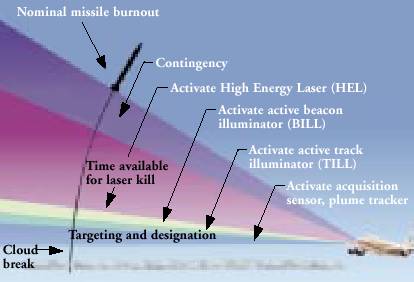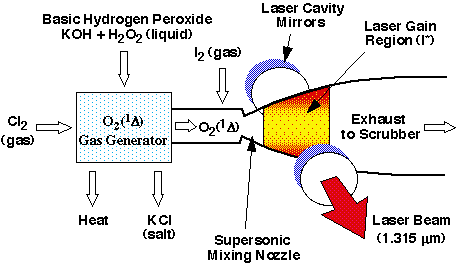 |
| Diagram of ABL.
From ABL cutaway on Team ABL site
|


 |
Nose Mounted Turret (Lockheed Martin).
From ABL cutaway
- 1.5 m telescope in turret focuses beams on missile and collects return
image and signals
- ±120 field-of-regard (azimuth)
- Extensive wind-tunnel tests by Boeing validate the design
- Flightweight composite construction
- Window stows until on cloud and dust-free aircraft orbit
- Protected against bird and lightning strike
Primary Mirror. See FAS
- Purpose : Target acquisition, tracking and beam direction
- Dimensions :
- Diameter : 1.6 meters
- Thickness : 20 cm
- Location : mounted in turret ball on front of aircraft
- Manufacturers :
|
|
|
 |
|
|
 |
Active Laser Ranger.
From ABL cutaway
- Modified 3rd generation LANTIRN with high-power CO2 laser
- Acquires target from IRST sensor cue, tracks target, and points CO2 laser for ranging
- Helps determine missile launch point and impact point
|
|
 |
Crew Safety (Boeing).
From ABL cutaway
- Station 1000 bulkhead/airlock provides controlled access to laser area in rear of aircraft
- Continuous remote- environment monitoring
|
|
 |
Illuminator Lasers.
From ABL cutaway
- Tracking illuminator laser (TILL)
- Beacon illuminator laser (BILL)
- Lasers are state-of-the-art diode- pumped, solid state devices
|
|
 |
High Energy Laser.
From ABL cutaway
- Chemical oxygen iodine laser (COIL) technology
- World record for chemical efficiency set by TRW
- Advanced materials-plastics, composites, titanium-used to reduce weight
- Modular design allows for graceful degradation
- Closed chemical system with recirculating reactants
- Designed for aircraft safety and field maintainability
|
|
 |
|
|
 |
Engines.
From ABL cutaway
- GE selected based on competitive bid
- CF6-80C2B5F is the highest thrust-rated engine (61,500 lb) available for 747-400
- Extensive reliability and service history
|
|
 |
Battle Management.
From ABL cutaway
- Human-machine interface
- Surveillance and tracking
- Launch and impact point predictions
- Theater interoperability and communications
- Target detection, identification, prioritization, and nomination
- Modular console construction
- Commercial hardware
- Common data/voice links (LINK 16/IBS) to joint theater assets
- Open systems architecture
- Boeing specs for BMC (PDF)
|
|


 |
Beam Control System.
From ABL cutaway
- Target acquisition and tracking (see Lockheed Martin Missiles and Space ABL site))
- Fire-control engagement sequencing, aim point-and-kill assessment
- High-energy laser (HEL) beam wavefront control and atmospheric compensation
- Jitter control, alignment/beam-walk control, and beam containment for HEL and illuminator lasers
- Calibration and diagnostics provide autonomous real-time operations and postmission analysis
|
|
 |
| Boeing wind tunnel tests in Seattle on a model of a modified 747 to confirm the design of
the nose turret that will aim the laser and on the laser exhaust system. See also
a closer view.
From ABL Team - Pics & Clips
and also
See also
from Air Force Technology : ABL YAL A1 |
 |
| TRW technicians preparing Flight-weighted Laser Module (FLM) which generates power in the multi-hundred kilowatt range, at Capistrano Test Site in Orange County, Calif.
From ABL Team - Pics & Clips
See also.
6 FLMs are linked together in ABL.
From Air Force Technology : ABL YAL A1 |
 |
|
Victor Buonadonna, senior systems engineer, left, and Dea Good, systems engineer, examine exhaust ports on
underside of ABL 747 model.
From ABL Team - Pics & Clips
See also
from Air Force Technology : ABL YAL A1 |
 |
| Fire Control Assembly uses realtime software and embedded processor to control target engagement.
(see also specifications (PDF)) |
 |
| Laser range versus theater missile hardness.
From Missile defense in modern war by Gregory H. Canavan |
 |
| ABL main laser and beacon laser firing at a target.
From ABL Team - Pics & Clips |
 |
| Artist conception of ABL 'firing' a shot
(also higher resolution image)
from Lockheed Martin Missiles and Space ABL photo archive
see smaller version
from Air Force Technology : ABL YAL A1
|
 |
|
 |
| Lockheed Martin and TRW working on scaled laser
beam control system. (Brassboard Test)
(also higher resolution image)
Photo credits, Russ Underwood, Lockheed Martin Missiles & Space
from Lockheed Martin Missiles and Space ABL photo archive
See smaller identical version of photo, where the researcher is not wearing protective eyewear ?!
From Air Force Technology : ABL YAL A1
|
 |
Laser mechanism. From UIUC Chemical Laser Group
- Uniform droplets are created by continuously flowing hydrogen peroxide liquid, H2O2,
and potassium hydroxide, KOH (or hair bleach and Drano). The fluid is passed through a device resembling
a vibrating shower head.
- Droplets interact with chlorine (Cl2) and helium gas (He), creating singlet delta oxygen,
O2(1D) and waste products such as heat and potassium chloride (KCl)
- Iodine (I2) is injected just before expansion, a
chemical reaction produces a laser photon :
- I2 + O2* ® I2* + O2
O2(1D) first excites I2
- I2* + O2* ® 2 I + O2
another O2(1D) dissociates excited I2 into 2 iodine atoms
- I + O2* ® I* + O2
Yet another O2(1D) tranfers energy to the iodine atom
- I* ® I + photon
Excited iodine atom emits a laser photon
- The mixture expands supersonically through a nozzle. (see
Computational fluid dynamics simulation of a COIL laser).
- Sealed exhaust system : to save weight some of the chemicals are recycled. H2O2 is recycled through the system several times until it's bleached beyond usefulness.
- Laser photons are amplified in a laser cavity consisting of two parallel mirrors placed around expanding gas.
- The beam emerging from the resonator propagates to the next module (out of 6) for further amplification.
- A series of high-precision steering mirrors direct the beam and correct for low-order distortion effects
such as the vibration of the plane.
- The adaptive optics deformable mirror has 341 actuators that change at 1,000 Hz to
correct for high-order effects such as optical turbulence that can cause beam diffraction and wavefront distortions.
|
|
 |
| Flame produced by a COIL laser.
From UIUC Chemical Laser Group |
 |
| Computer simulation of I2 molecule nozzle concentration after it penetrates and mixes with the main flow.
(from Madden,T.: 1997 PhD Thesis using
GASP software. |
 |
| Distribution of iodine in nozzle, cross-section is through centerline of large injection hole
from Detailed COIL performance calculations. Lampson,A.I. et al. Maui High Performance Computing Center
|
 |
| Dr. Keith Truesdell demonstrating the
VertiCoil a smaller version of the ABL laser at Phillips Lab where the COIL laser was invented in 1977.
(a smaller image)
from 'Set Lasers on Stun', Airman magazine, April 1997 |
 |
| Oscura-3 facility 1-meter telescope on 8,000-foot
North Oscura Peak
measures atmospheric distortions towards Salinas Peak (approx. 57 km south) using
a 300 W tracking laser, a 50-200 W adaptive-optics beacon laser and
a 10-40 W scoring laser which acts as a surrogate for high-energy laser weapons.
A Cessna Caravan aircraft was also used as a target.
Dynamic compensation experiment for beam control system demonstrated
up to a factor 20 improvement between uncompensated and compensated laser spots.
From Air Force Research Laboratory, White Sands Missile Range, N.M. (AFPN) Jan. 22, 1999
see also Lab completes laser experiment, Sep, 1999. Air Force News.
|
 |
| Another view of Oscura 3 facility.
From Hardin, R.W.: 1999, OE Reports 184, April. Megawatt laser moves airborne defense into new era. |
 |
| Map of companies contributing to ABL project |






























